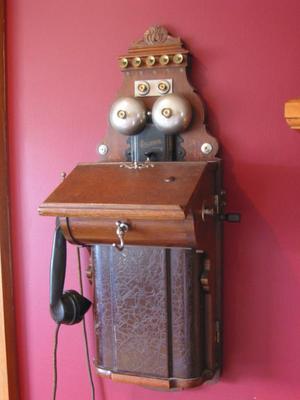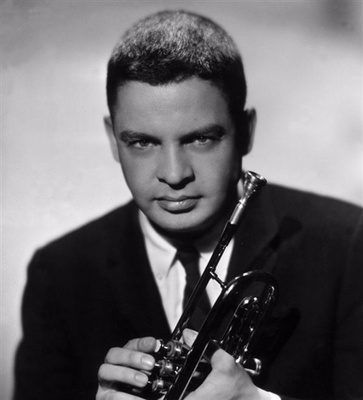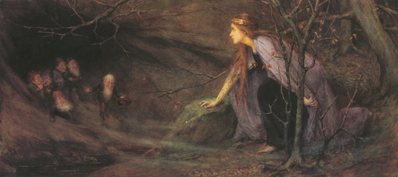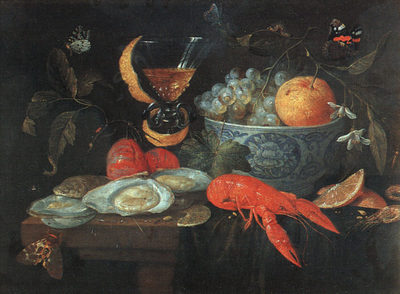
It's amazing, a wonder, that one wakes up in the morning.
---Nagarjuna
Better a handful of quietness Than both hands full of toil And much chasing the wind.
---Ecclesiastes
I have to let go of the need to know so much. What we can know is so small---the holiness around is so large. Now I trust in simplicity, simplicity and love.
---Hindu sage
This morning I received an atypical communique from a friend who is Professor Emeritus of Anthropology and Sociology at Ohio University. Ordinarily he checks stuff I send out with a meticulous eye and lets me know when I get carried away. This time his eye seems a little moist and I readily admit he got me that way too...with this wonderful story~~~
When I was quite young, my father had one of the first telephones in our neighbourhood. I remember well the polished old case fastened to the wall. The shiny receiver hung on the side of the box. I was too little to reach the telephone, but used to listen with fascination when my mother used to talk to it.
Then I discovered that somewhere inside the wonderful device lived an amazing person - her name was "Information Please" and there was nothing she did not know. "Information Please" could supply anybody's number and the correct time.
My first personal experience with this genie-in-the-bottle came one day while my mother was visiting a neighbour. Amusing myself at the tool bench in the basement, I whacked my finger with a hammer. The pain was terrible, but there didn't seem to be any reason in crying because there was no one home to give sympathy. I walked around the house sucking my throbbing finger, finally arriving at the stairway.
The telephone! Quickly, I ran for the footstool in the parlour and dragged it to the landing. Climbing up, I unhooked the receiver in the parlour and held it to my ear. "Information Please," I said into the mouthpiece just above my head. A click or two and a small clear voice spoke into my ear. "Information."
"I hurt my finger. . ." I wailed into the phone. The tears came readily enough now that I had an audience. "Isn't your mother home?" came the question.
"Nobody's home but me." I blubbered.
"Are you bleeding?"
"No," I replied. "I hit my finger with the hammer and it hurts."
"Can you open your icebox?" she asked. I said I could. "Then chip off a little piece of ice and hold it to your finger," said the voice.
After that, I called "Information Please" for everything. I asked her for help with my geography and she told me where Philadelphia was. She helped me with my math. She told me my pet chipmunk that I had caught in the park just the day before would eat fruits and nuts. Then, there was the time Petey, our pet canary died. I called "Information Please" and told her the sad story. She listened, then said the usual things grown-ups say to soothe a child. But I was un-consoled. I asked her, "Why is it that birds should sing so beautifully and bring joy to all families, only to end up as a heap of feathers on the bottom of a cage?"
She must have sensed my deep concern, for she said quietly, "Paul, always remember that there are other worlds to sing in." Somehow I felt better. Another day I was on the telephone. "Information Please."
"Information," said the now familiar voice.
"How do you spell 'fix'?" I asked.
All this took place in a small town in the Pacific Northwest. When I was 9 years old, we moved across the country to Boston. I missed my friend very much. "Information Please" belonged in that old wooden box back home, and somehow never thought of trying the tall, shiny new phone that sat on the table in the hall. As I grew into my teens, the memories of those childhood conversations never really left me. Often, in moments of doubt and perplexity I would recall the serene sense of security I had then. I appreciated now how patient, understanding, and kind she was to have spent her time on a little boy.
A few years later, on my way west to college, my plane put down in Seattle. I had about half an hour or so between planes. I spent 15 minutes or so on the phone with my sister, who lived there now. Then, without thinking what I was doing, I dialed my hometown operator and said, "Information, Please." Miraculously, I heard the small, clear voice I knew so well, "Information." I hadn't planned this but I heard myself saying, "Could you please tell me how to spell 'fix'?"
There was a long pause. Then came the soft spoken answer, "I guess your finger must have healed by now."
I laughed. "So it's really still you," I said. "I wonder if you have any idea how much you meant to me during that time." "I wonder," she said, "if you know how much your calls meant to me. I never had any children, and I used to look forward to your calls." I told her how often I had thought of her over the years and I asked if I could call her again when I came back to visit my sister.
"Please do, she said. "Just ask for Sally."
Three months later I was back in Seattle. A different voice answered "Information." I asked for Sally. "Are you a friend?" she asked. "Yes, a very old friend," I answered.
"I'm sorry to have to tell you this", she said. "Sally had been working part-time the last few years because she was sick. She died five weeks ago."
Before I could hang up she said, "Wait a minute. Is your name Paul?"
"Yes."
"Well, Sally left a message for you. She wrote it down in case you called. Let me read it to you. The note says, 'Tell him I still say there are other worlds to sing in. He'll know what I mean.'"
I thanked her and hung up. I knew what Sally meant. Never underestimate the impression you may make on others. On that note I would like to ask you to remember how much difference one person can make in someone's life.
And now, when you've recovered, the item I sent back to my friend~~~
ORIGINS: Some of us tend to think the Internet age spawned the current spate of sentimental tales, because for many our first contact with these gems was their appearance in our inboxes. Yet glurge [link] has been circulating in its current form for decades, as evidenced by this current story about the friendship between a little boy and a telephone operator. "Information, Please" was first published in 1966 in Reader's Digest, a magazine known for offering at least one of these "slice of life" heartwarming yarns in each issue.
There are differences between the version circulated on the Internet (which is the text used as the example above) and the original as it appeared in Reader's Digest. For the most part, these differences amount to the dropping of a line here and there, the changing of one word into another (the "tall, skinny new phone" becomes the "tall, shiny new phone"), and the rendering of words from the original story with British rather than American spellings ("neighbor" instead of "neighbour"; "parlor" instead of "parlour"). Perhaps whoever transcribed this story from the original was working with a hard-to-read photocopy.
There are also two key departures: one of omission; the other of addition. Omitted is a lengthy anecdote that should have immediately followed the "How do you spell 'fix'?" line, about the author's having been given a fright by his sister that resulted in his pulling the telephone receiver from the wall-mounted unit and the quick appearance of a repairman to fix the phone and to inform "Information Please" that the children were all right. (The phone conversation had been unexpectedly interrupted after a loud scream was heard in the background, so the operator had dispatched someone to check what happened.)
Added are the two lines that now close the piece: "Never underestimate the impression you may make on others. On that note I would like to ask you to remember how much difference one person can make in someone's life." In the original, the story concluded with "I thanked her and hung up. I did know what Sally meant." Unlike whoever took it upon himself to edit the piece, Paul Villiard trusted his readers to understand the moral of his tale.
Is this particular entry a true story? It (like many others) was presented as a "first person tale," but glurge-like stories are often full of embellishments and exaggerations — and are sometimes complete fabrications — despite their "true story" labels, and tracking down the originator of a single 36-year-old piece is no easy task. As usual, the better approach to this type of narrative might be to ignore the issue of its literal truthfulness and consider the message: Does this wistful tale truly represent life as it was — a now-gone world in which even anonymous telephone operators took time out to comfort lonely children by helping them treat their injuries, assisting them with their homework, and offering them bits of philosophical advice — or does it represent a way of life we'd like to believe in, one that never really existed outside our imaginations?
Sources:
Canfield, Jack. A 3rd Serving of Chicken Soup for the Soul. Deerfield Beach, FL: Health Communications, 1996. ISBN 1-55874-379-0 (pp. 14-18). Villiard, Paul. "Information, Please." Reader's Digest. June 1966 (pp. 63-65).
The URL for this page is http://www.snopes.com/glurge/infoplea.htm Urban Legends Reference Pages © 1995-2004 by Barbara and David P. Mikkelson



